Phloem is a complex tissue of a plant, first introduced by a scientist Nageli in 1853. It is a part of the plant’s vascular system that involves the translocation of organic molecules from the leaves to the different parts of plants like stem, flowers, fruits and roots. Numerous specialized tissues (vascular tissues) contribute to a structure called phloem, which conducts the food supply in the vascular plants.
It consists of living cells like sieve cells, companion cells, phloem parenchyma and the phloem fibres (the only dead cells). In vascular plants, phloem functions as a food conducting tissue that typically transports the photoassimilates (photosynthetic food). It carries the photoassimilates from the site of photosynthesis (leaves) to the non-photosynthetic parts of the plants (stems and roots).
The food it carries is termed as phloem sap. The photosynthetic food is actively transported from the leaves to the other parts of the vascular plants via turgor pressure and ATP. You will get to know the definition, classification (based on the origination), structural components, important characteristics and facts about phloem.
Content: Phloem
Definition of Phloem
Phloem is defined as the specialized food conducting tissue of the plant cell, which assist the conductance of food (carbohydrates and amino acids) from the photosynthesized part (leaf) to the non-photosynthesized parts (like stem, flowers, buds, fruits, roots). Therefore, it primarily translocates the soluble organic molecules like amino acids, sugars etc. as sources of food and energy to the plant’s remaining parts. The food translocation is carried out from the source tissues (leaves) to the sink tissues (stem, roots, etc.).
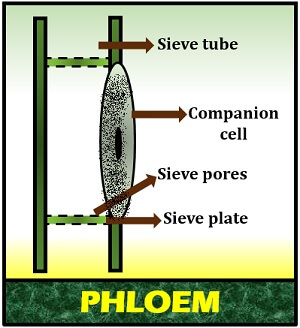
Classification
The phloem can be classified into two types, based on its origination and maturation:
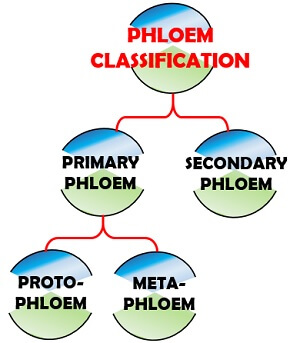
- Primary phloem: It originates from the procambium (develops during the plant’s primary growth). It then develops into protophloem and metaphloem. Protophloem appears first consists of narrow sieve tubes, whereas the metaphloem develops later and possesses broad sieve tubes.
- Secondary phloem: It originates from the vascular cambium during the secondary growth of the plant.
Characteristics
In most plants, the existence of phloem in both stem and roots is found external to the xylem.
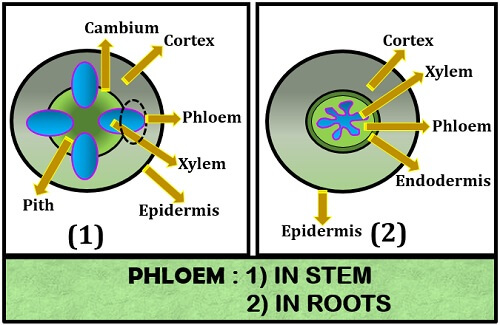
Generally, the phloem may exist either internal or external to the xylem. Its position internal to the xylem is called internal phloem and position external to the xylem is termed as external phloem.
The phloem generally exists on the lower side or abaxial surface of the leaf. But, some plants species of the Cucurbitaceae and Convolvulaceae family, it is present on both the adaxial and abaxial surface of the leaves.
The phloem internal to the secondary xylem is called inter xylary phloem, which generally exists in two forms (either as concentric rings or radial strands).
Structure of Phloem
The structural components of the phloem are as follows:
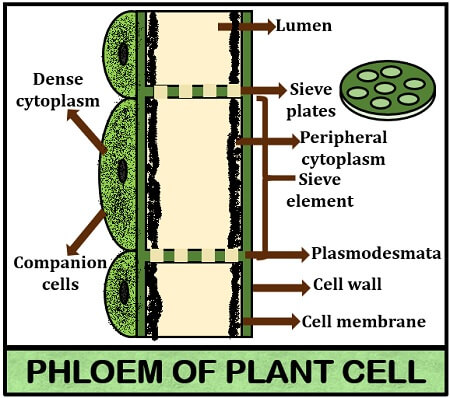
Sieve Elements
It is an essential element composed of living cells (sieve tube and sieve cells). Sieve tubes conduct food transfer. Cellulose microfibrils function as a major constituent of the sieve tube that provides mechanical strength to the sieve tube. Sieve plate also allows back and forth movement of sap through the holes.
- Sieve tube: It appears as a long and slender tube joined to the adjacent sieve tube from end to end. At the end of the sieve tube, a perforated sieve plate consists of many sieves or sieve pores. Sieve tubes lack nucleus and cell organelles like the Golgi body, ribosomes, endoplasmic reticulum, which is a peculiar feature differentiating it from the other components. On plant maturation, the sieve tube develops a large vacuole that shifts the cytoplasm towards the periphery and appears thin.
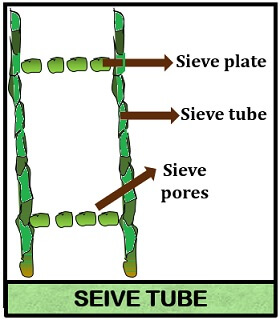
- Sieve cells: These are long, thin-walled with tapering ends. Sieve pores are present all over the surface of the sieve cell in contrast to sieve tubes.
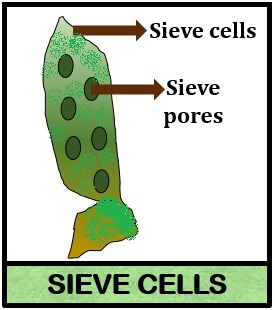
Companion Cells
These are also the living components of the plant cell associated with each sieve tubes. Companion cells contain its own nucleus, by which they not only control their own activity but also controls the activity of the neighbouring sieve tubes. They are also called modified parenchyma, which comprises dense cytoplasm and cell organelles. Due to the presence of cell organelles, the companion cells are metabolically very active. Companion cells release ATP for the translocation of food and thereby helps in food conductance.
- Plasmodesmata: These are the cytoplasmic strands that function as a connecting link between the sieve tube and the companion cells.
- Lumen: It is the empty space of the tube or lacks cell organelles.
- Cell wall: It is the outermost covering of the sieve tube. The cell wall provides resistance to the sieve tube from the high pressure.
- Cell membrane: It is the phospholipid bilayer membrane present interior to the cell wall. Cell membrane holds the sap inside the tube and pumps sucrose in and out of the sieve tube.
- Phloem parenchyma: It is also a living component composed of parenchyma cells. It is responsible for the radial conduction of food and acts as storage cells that store latex, resins etc.
- Phloem fibre: It is the only dead element, composed of sclerenchyma. It seems like a thick-walled structure with a narrow cavity and tapering ends. Phloem fibres provide mechanical strength to the cell. Certain plants like Hibiscus, Cannabis, and Linum etc. are important for the commercial production of fibre.
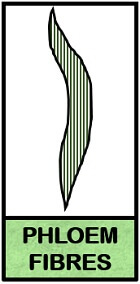
Important Facts
- Presence of sieve tube is one of the identifying features of the Angiosperms.
- During the winters, the sieve pores of the sieve tube are blocked by the callose carbohydrate called callose plugs. The callose plug will block the passage of sap through the sieve pores or stops the conductance of food. As the spring season comes, the callose that has blocked the sieve pores will dissolve due to the temperature rise and cause sieve pores’ opening.
- The presence of sieve cells is the identifying feature that occurs in Gymnosperms and Pteridophytes.
- Sieve tube and the companion cells are colloquially known as sister cells because both have originated from a single mother cell.
- In gymnosperms and pteridophytes, companion cells are absent.
- Gymnosperms (particularly conifers) consist of albuminous cells in place of the companion cells.
- Phloem parenchyma is absent in monocots.
Functions
- Phloem helps in the food conductance like sugar, amino acids etc. from leaves to the other parts of plants.
- It can also help in the transportation of proteins and mRNAs.
- The sieve tubes of phloem give strength to the plant against cell bursting.
- Sieve plate allows the continuous movement of sap through the sieve pores both in a forward and backward direction that keeps the cell hydrated.
- Phloem parenchyma can store ergastic materials like resin, latex etc.
Conclusion
Therefore, phloem helps in the translocation of food from the source (Leaves) and sinks it to the other parts that are used up for the plant’s growth and other activities.
Really helpful